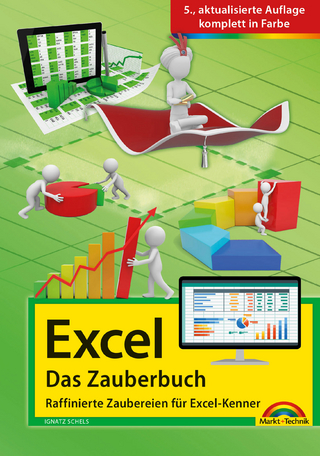Microsoft Excel Data Analysis and Business Modeling (Office 2021 and Microsoft 365)
Addison Wesley (Verlag)
978-0-13-761366-3 (ISBN)
Solve real problems with Microsoft Excel—and build your competitive advantage
Quickly transition from Excel basics to sophisticated analytics
Use recent Power Query enhancements to connect, combine, and transform data sources more effectively
Use the LAMBDA and LAMBDA helper functions to create Custom Functions without VBA
Use New Data Types to import data including stock prices, weather, information on geographic areas, universities, movies, and music
Build more sophisticated and compelling charts
Use the new XLOOKUP function to revolutionize your lookup formulas
Master new Dynamic Array formulas that allow you to sort and filter data with formulas and find all UNIQUE entries
Illuminate insights from geographic and temporal data with 3D Maps
Improve decision-making with probability, Bayes' theorem, and Monte Carlo simulation and scenarios
Use Excel trend curves, multiple regression, and exponential smoothing for predictive analytics
Use Data Model and Power Pivot to effectively build and use relational data sources inside an Excel workbook
Wayne L. Winston is Professor Emeritus of Decision Sciences at the Indiana University School of Business. He has also taught at the University of Houston and Wake Forest. He has won more than 40 teaching awards and taught Excel modeling and analytics at many Fortune 500 companies, accounting firms, the U.S. Army, and the U.S. Navy. He is a two-time Jeopardy! champion, and also is a co-developer of a player tracking system utilized by Mark Cuban and the Dallas Mavericks.
CHAPTER 1 Basic worksheet modeling
CHAPTER 2 Range names
CHAPTER 3 Lookup functions
CHAPTER 4 The INDEX function
CHAPTER 5 The MATCH function
CHAPTER 6 Text functions and Flash Fill
CHAPTER 7 Dates and date functions
CHAPTER 8 The net present value functions: NPV and XNPV
CHAPTER 9 The internal rate of return: IRR, XIRR, and MIRR functions
CHAPTER 10 More Excel financial functions
CHAPTER 11 Circular references
CHAPTER 12 IF, IFERROR, IFS, CHOOSE, SWITCH, and the IS functions
CHAPTER 13 Time and time functions
CHAPTER 14 The Paste Special command
CHAPTER 15 Three-dimensional formulas and hyperlinks
CHAPTER 16 The auditing tool and the Inquire add-in
CHAPTER 17 Sensitivity analysis with data tables
CHAPTER 18 The Goal Seek command
CHAPTER 19 Using the Scenario Manager for sensitivity analysis
CHAPTER 20 The COUNTIF, COUNTIFS, COUNT, COUNTA, and COUNTBLANK functions
CHAPTER 21 The SUMIF, AVERAGEIF, SUMIFS, AVERAGEIFS, MAXIFS, and MINIFS functions
CHAPTER 22 The OFFSET function
CHAPTER 23 The INDIRECT function
CHAPTER 24 Conditional formatting
CHAPTER 25 Excel tables and table slicers
CHAPTER 26 Spin buttons, scrollbars, option buttons, check boxes, combo boxes, and group list boxes
CHAPTER 27 Importing data from a text file or document
CHAPTER 28 The Power Query Editor
CHAPTER 29 Excel's new data types
CHAPTER 30 Summarizing data with histograms and Pareto charts
CHAPTER 31 Summarizing data with descriptive statistics
CHAPTER 32 Sorting in Excel
CHAPTER 33 Filtering data and removing duplicates
CHAPTER 34 Summarizing data with database statistical functions
CHAPTER 35 Array formulas and functions
CHAPTER 36 Excel's new dynamic array functions
CHAPTER 37 Validating data
CHAPTER 38 Using PivotTables and slicers to describe data
CHAPTER 39 The Data Model
CHAPTER 40 Power Pivot
CHAPTER 41 Consolidating data
CHAPTER 42 Creating subtotals
CHAPTER 43 Basic charting
CHAPTER 44 Advanced charting
CHAPTER 45 Filled and 3D Maps
CHAPTER 46 Sparklines
CHAPTER 47 Estimating straight-line relationships
CHAPTER 48 Modeling exponential growth
CHAPTER 49 The power curve
CHAPTER 50 Using correlations to summarize relationships
CHAPTER 51 Introduction to multiple regression
CHAPTER 52 Incorporating qualitative factors into multiple regression
CHAPTER 53 Modeling nonlinearities and interactions
CHAPTER 54 Analysis of variance: One-way ANOVA
CHAPTER 55 Randomized blocks and two-way ANOVA
CHAPTER 56 Using moving averages to understand time series
CHAPTER 57 Ratio-to-moving-average forecast method
CHAPTER 58 An introduction to probability
CHAPTER 59 An introduction to random variables
CHAPTER 60 The binomial, hypergeometric, and negative binomial random variables
CHAPTER 61 The Poisson and exponential random variable
CHAPTER 62 The normal random variable and Z-scores
CHAPTER 63 Making probability statements from forecasts
CHAPTER 64 Using the lognormal random variable to model stock prices
CHAPTER 65 Importing past stock prices, exchange rates, and cryptocurrency prices with the STOCKHISTORY function
CHAPTER 66 An introduction to optimization with Excel Solver
CHAPTER 67 Using Solver to determine the optimal product mix
CHAPTER 68 Using Solver to schedule your workforce
CHAPTER 69 Using Solver to solve transportation or distribution problems
CHAPTER 70 Using Solver for capital budgeting
CHAPTER 71 Using Solver for financial planning
CHAPTER 72 Using Solver to rate sports teams
CHAPTER 73 The Winters method and the Forecast Sheet tool
CHAPTER 74 Forecasting in the presence of special events
CHAPTER 75 Warehouse location and the GRG Multistart and Evolutionary Solver engines
CHAPTER 76 Penalties and the Evolutionary Solver
CHAPTER 77 The traveling salesperson problem
CHAPTER 78 Weibull and beta distributions: Modeling machine life and duration of a project
CHAPTER 79 Introduction to Monte Carlo simulation
CHAPTER 80 Calculating an optimal bid
CHAPTER 81 Simulating stock prices and asset-allocation modeling
CHAPTER 82 Fun and games: Simulating gambling and sporting-event probabilities
CHAPTER 83 Using resampling to analyze data
CHAPTER 84 Pricing stock options
CHAPTER 85 Determining customer value
CHAPTER 86 The economic order quantity inventory model
CHAPTER 87 Inventory modeling with uncertain demand
CHAPTER 88 Queuing theory: The mathematics of waiting in line
CHAPTER 89 Estimating a demand curve
CHAPTER 90 Pricing products by using tie-ins
CHAPTER 91 Pricing products by using subjectively determined demand
CHAPTER 92 Nonlinear pricing
CHAPTER 93 Use Analyze Data to find patterns in your data
CHAPTER 94 Recording macros
CHAPTER 95 The LET and LAMBDA functions and the LAMBDA helper functions
CHAPTER 96 Advanced sensitivity analysis
| Erscheinungsdatum | 23.12.2021 |
|---|---|
| Reihe/Serie | Business Skills |
| Verlagsort | Boston |
| Sprache | englisch |
| Maße | 188 x 232 mm |
| Gewicht | 1800 g |
| Themenwelt | Informatik ► Office Programme ► Excel |
| Informatik ► Office Programme ► Outlook | |
| ISBN-10 | 0-13-761366-0 / 0137613660 |
| ISBN-13 | 978-0-13-761366-3 / 9780137613663 |
| Zustand | Neuware |
| Informationen gemäß Produktsicherheitsverordnung (GPSR) | |
| Haben Sie eine Frage zum Produkt? |
aus dem Bereich




